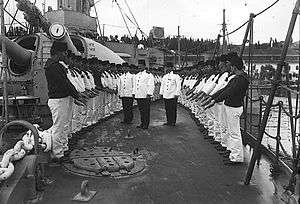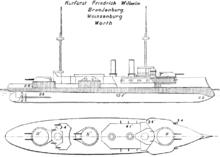28 cm MRK L/40
| 28 cm MRK L/40 | |
|---|---|
 The Ottoman battleship Barbaros Hayreddin or Turgut Reis. | |
| Type |
Naval gun Railway gun |
| Place of origin | German Empire |
| Service history | |
| Used by |
German Empire Ottoman Empire |
| Wars |
Boxer Rebellion World War I |
| Production history | |
| Designer | Krupp |
| Designed | 1891 |
| Manufacturer | Krupp |
| Specifications | |
| Weight | 44 t (43 long tons; 49 short tons) |
| Length | 11.2 m (36 ft 9 in) L/40 |
| Barrel length | 10.4 m (34 ft 1 in)[1] |
|
| |
| Shell | Separate-loading, bagged charge and projectile |
| Shell weight | 240 kg (530 lb) |
| Caliber | 283 mm (11.1 in)[1] |
| Breech | Horizontal sliding-wedge |
| Elevation | -5° to +25° |
| Traverse | -150° to +150°[2] |
| Rate of fire | 1 round every two minutes |
| Muzzle velocity | 715 m/s (2,350 ft/s) |
| Effective firing range | 11 km (6.8 mi) at 25° |
| Maximum firing range | 15 km (9.3 mi) at 25°[1] |
The 28 cm MRK L/40 was a German naval gun that was used in World War I as the primary armament of the Brandenburg-class pre-dreadnought battleships. Some were also converted to railway guns during World War I.
Design
The 28 cm MRK L/40 gun was a built-up gun made from three layers of reinforcing hoops. It used a cylindro-prismatic horizontal sliding breech, but unlike later Krupp guns it did not use a metallic cartridge case. Instead, it used separate loading bagged charges and projectiles.[1]
The four ships of the Brandenburg class had a slightly unusual arrangement for their primary armament. Although the primary armament consisted of six 28 cm guns in three twin gun turrets that all fired the same ammunition, the fore and aft turrets had 28 cm MRK L/40 guns, while the amidships turret had 28 cm MRK L/35 guns due to space constraints. The ships did not have centralized fire control and each gun type had different ballistics. The L/35 guns had a muzzle velocity of 685 m/s (2,250 ft/s) and a maximum range of 14.45 km (8.98 mi) vs 715 m/s (2,350 ft/s) and a maximum range of 15 km (9.3 mi) for the L/40 guns.[1]
Railway artillery
When the two Brandenburg-class ships still in German service SMS Brandenburg and SMS Wörth were relegated to training duties in 1915 six of the L/40 guns were transferred to the Army where they were known as 28 cm K L/40 "Kurfürst" guns. These were installed on Eisenbahn und Bettungsschiessgerüst (E. u. B.) (railroad and firing platform) mounts successfully used by other German railroad guns. Unlike every other large German railroad gun, it used a massive rectangular cradle for its gun.[3]
The six "Kurfürst" guns entered service in early 1918, participating in the German Spring Offensive and the subsequent defensive operations.[3] They were organized into Batteries 393, 434, 722 and the First through Third Batteries of Bavarian Foot Artillery Battalion (1.-3./Bayerische Fußartillerie-Batallion) 29 with one gun each.[4] All six were destroyed in 1921–22 by the Military Inter-Allied Commission of Control.[5]
Ammunition
Before and during World War I, the gun used about 56.6 kg (125 lb) of RP C/12 (Rohr-Pulver – tube powder)[2] propellant that was a mix of nitrocellulose, nitroglycerin and small amounts of other additives with a calorific value of 950 and an uncooled explosion temperature of 2,975 kelvins.[6]
| Shell name | Weight | Filling Weight | Armor Penetration |
|---|---|---|---|
| Armor-piercing shell (Panzergrenate L/2.6) | 240 kg (530 lb) | unknown | 160 mm (6.3 in) at 13.12 km (8.15 mi). |
| High-explosive shell (Sprenggranate L/2.9) | 240 kg (530 lb) | 15.9 kg (35 lb) HE | unknown[2] |
Photo gallery
| Wikimedia Commons has media related to Brandenburg class battleship. |
| Wikimedia Commons has media related to 28 cm L/40 Kurfürst. |
 The Brandenburg class as depicted in Brassey's Naval Annual 1902
The Brandenburg class as depicted in Brassey's Naval Annual 1902 SMS Wörth
SMS Wörth SMS Brandenburg
SMS Brandenburg.jpg) A converted railroad gun
A converted railroad gun
References
- 1 2 3 4 5 Friedman, Norman (2011). Naval Weapons of World War One. S. Yorkshire: Seaforth Pub. p. 137. ISBN 9781848321007. OCLC 751804655.
- 1 2 3 DiGiulian, Tony. "28 cm/40 (11") MRK L/40". www.navweaps.com. Retrieved 2018-08-19.
- 1 2 François, p. 32
- ↑ François, p. 12
- ↑ François, p. 47
- ↑ Campbell, John (1985). Naval weapons of World War Two. Annapolis, Md.: Naval Institute Press. p. 21. ISBN 0870214594. OCLC 13085151.
Bibliography
- François, Guy. Eisenbahnartillerie: Histoire de l'artillerie lourd sur voie ferrée allemande des origines à 1945. Paris: Editions Histoire et Fortifications, 2006